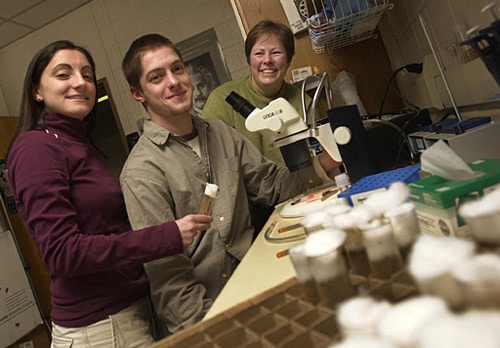It may be hard to imagine that insects have brains, but fruit flies do make decisions, says a Lafayette professor, even if they’re as basic as “deftly circle swatting hand” and “land on, eat peach now!”
“Their systems are a lot simpler, but that makes them a better system to study,” says Elaine Reynolds, assistant professor of biology.
Two of Reynolds’ premedical students examined something even tinier than the drosophila fruit fly’s brain: components of that brain, and their role in the seizure-like behavior in one fly mutant. Neuroscience majors Jodi Antonelli ’02 (Hazleton, Pa.) and Andrew Saunders ’02 (Albion, NY) used a radioactive label to determine which parts of the fly’s brain, if any, are linked to a “bang-sensitive” reaction. When jarred by a mechanical shock such as a rap on the table, the “bang-sensitive” fly goes into a temporary seizure-like state that could offer insight into developing a model for epilepsy in higher organisms, the students say.
After pursuing the research as independent studies during the fall, Antonelli and Saunders worked over the interim session as EXCEL Scholars.
“They looked at the brain regions and did a scan that could be involved in the bang,” says Reynolds. In addition to this project, Saunders tried to determine how the fly perceives the shock, which may be through certain bristles made for touch and hearing getting ruffled, says the professor.
“It went very well. They’re both great students,” Reynolds says. “They did excellently in designing the experiments.”
Saunders and Antonelli, who both plan to go to medical school, took on the project to shed light on the mysteries of human epilepsy and gain laboratory skills.
“It was great to work on an experiment of my own design and not a previously investigated protocol,” says Saunders. “I enjoyed watching the evolution from idea to results that happened this year and will continue throughout the rest of my time at Lafayette. The college has been great. I’ve had a good time here.”
He adds, “This experience was greatly beneficial as I will be spending a good deal of time in the laboratory throughout my education.”
Antonelli says it was “a wonderful experience because I did not do a project that someone else started. Dr. Reynolds, Andrew, and I completely developed this project and it was challenging and exciting to see this research evolve from an idea to actual experimentation.” She says the work provided her with the foundation to understand, appreciate and hopefully contribute to science in her career.
In addition, both students enjoyed the atmosphere of the January interim session between semesters, which Antonelli says gave her a chance to concentrate completely on the project without responsibility for class work and to do some side projects she usually doesn’t have time to conduct.
“This was the first interim I spent on campus,” says Saunders. “The much smaller student population was very relaxing and provided an intimate setting.”
A graduate of Hazleton Area High School, Antonelli is treasurer of C.O.R.R.E., a volunteer at the Third Street Alliance Women’s Shelter, a member of Psi Chi, a peer tutor, a biology teaching assistant, and a psychology lab assistant.
Saunders, who graduated from Albion High School, is a biology teaching assistant, Psi Chi member, and peer tutor.

Jodi Antonelli ’02 and Andrew Saunders ’02, both behavioral neuroscience majors, analyzed the brain structure and function of drosophila fruit flies in an EXCEL Scholars project with Elaine Reynolds, associate professor of biology.
